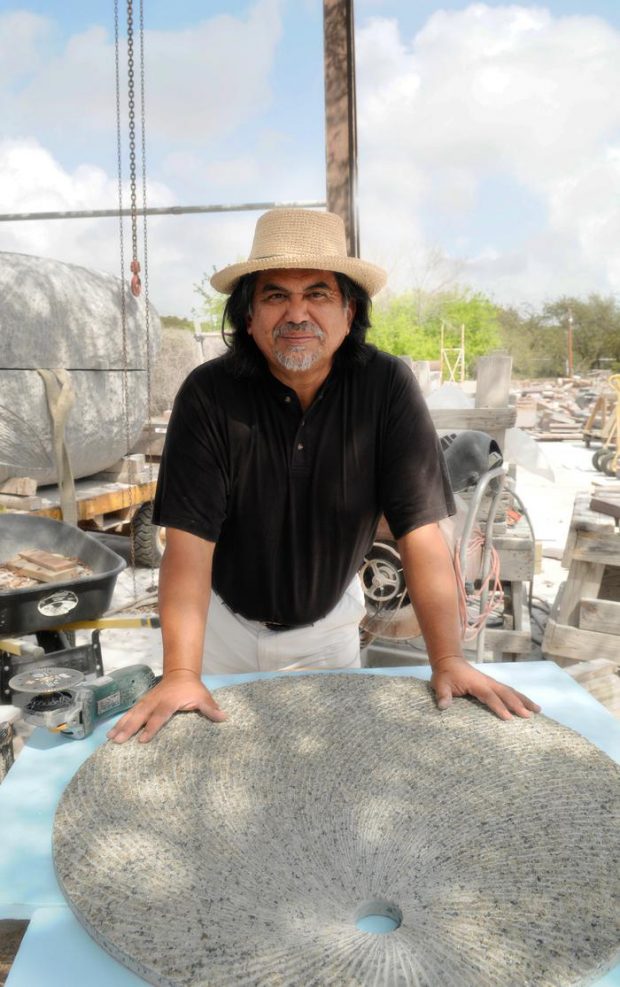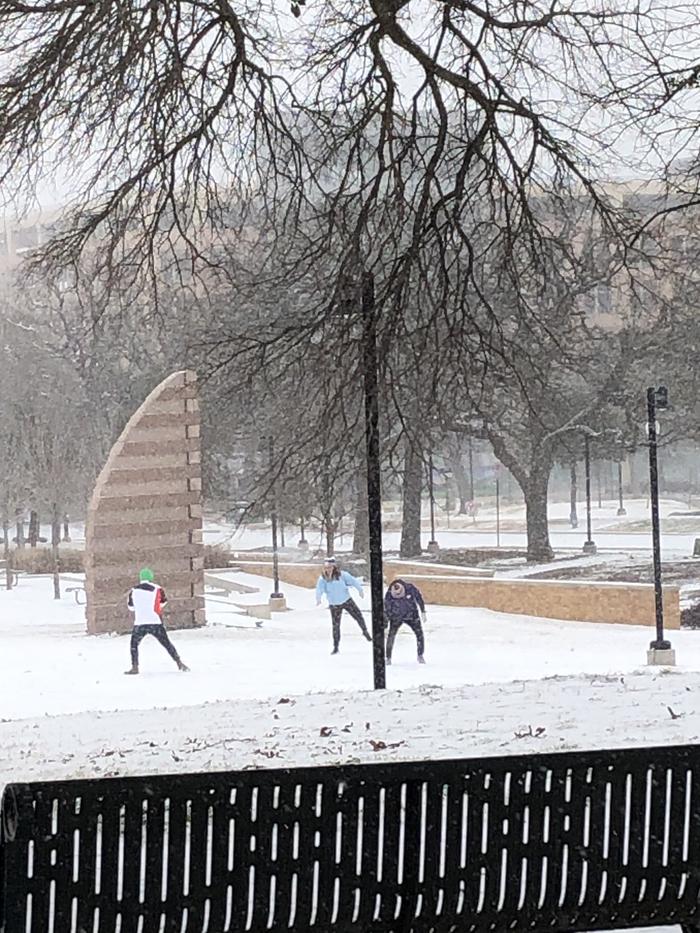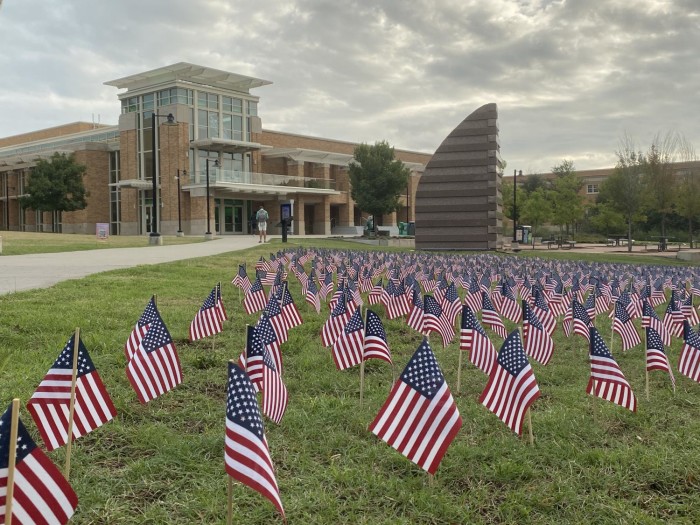Students walking on the south side of the University Union, near Highland Street, have the opportunity to view a sculpture by a world-famous artist and UNT alumnus, Jesús Moroles.
Jesús Bautista Moroles (1950-2015) was born in Corpus Christi. He was the eldest child in a family of six children. He was named after an uncle, who was sent to fight in the Korean War. He grew up in the Oak Cliff neighborhood of Dallas, attending the Sidney Lanier Expressive Arts Vanguard School in that city. In high school, he learned silk screening. His work ethic and entrepreneurial spirit were on full display when he started to produce spirit items with his school logo. He eventually expanded to producing similar products for other schools. By the end of High School, he had developed his own business.
After graduating from Crozier Technical High School, Moroles received his draft notice in 1969. He enlisted in the Air Force, but he had to take a test to prove that the Air Force should accept him. His math results were high, and the Air Force took him in to fill an emerging field, computing, that they needed to fill. He took two years of technical training and became an electronics repairman. This was during the Vietnam War. He would serve for four years.
When he returned home, Moroles enrolled in El Centro College. He enrolled and took a year of nothing but art courses. He was asked who his counselor was and confessed that he did not have one. He then had to take the academic courses that he needed for a diploma. He earned an associate’s degree from El Centro College, Dallas.
He then enrolled at North Texas State University (now the University of North Texas). Moroles studied sculpture with Mike Cunningham. It was during this time that he realized that he wanted to work with granite. His Bachelor of Fine Arts degree was earned in 1978.
“That’s [Granite] the only thing I work with it was the hardest thing I tried. I liked the challenge.” Jesús Moroles [Smithsonian Oral History with Ms. Cary Cordova]
His education also included working as an apprentice for Luis Jimenez, a figurative artist, for a year. He then spent a year in Carrara, Italy studying sculpture. Upon his return, Moroles moved to Waxahachie where he rented space in a stone carver’s factory.
He moved to Rockport in 1983 to live near his family.
“I moved here to be close to my parents, so they could keep an eye on me. You know, I grew up leaving home when I was drafted, and then gone for four years, then to college for four years, and then was an apprentice, and was gone- and then To Italy. So I was gone for 10 years, and so it was the first chance that I could kind of get back…” Jesús Moroles [Smithsonian Oral History with Ms. Cary Cordova]
He built a studio to hold his sculpture equipment and stones he had picked out for future sculptures. Moroles technique to carve the granite was to drill holes in the stone and then use wedges to “tear” the stone. This process exposes the interior of the stone, creating the design and the texture of the artwork.
“The stone itself is the starting point. I always choose pieces that already suggest their final form. By working directly in response to the character of the stone, I hope to expose the truth of the material.” Jesús Moroles [Dallas Independent School District]
“And so we drill holes in it and put wedges in it and play them like tuning forks and create pressure, and then all of a sudden it explodes open and falls apart.” Jesús Moroles [Smithsonian Oral History with Ms. Cary Cordova]
Moroles came back to UNT to participate in a performance combining music and dancers with his “tearing” the stone known as “Thunder in the Stone: Tearing Granite” in 1993. The concept for the piece came from his experience of being on an airplane and flying through a thunderstorm. David Shrader, dean of Music, and Larry Austin (musician), and Sandra Combest (choreographer) were involved in the production. The production combined dance, dramatic noise, and the visual show of the carving of the stone to make a sculpture. The show would also be performed at the Davis/McClain Gallery.
Moroles also traveled widely. His sculptures are now installed around the world. A few of these countries include Mexico, Egypt, China, France, Italy, and the United States. In Egypt, he was able to visit the quarries where the stone for the ancient carvings and monuments came from. He was also able to carve that stone. He ended up with an eighteen-foot granite sail. He made numerous trips to China. On his first trip to China, Moroles stayed for two months and created a Spirit Fountain.
His sculptures can be seen closer to the UNT campus at the Dallas Museum of Art; the Modern Art Museum of Fort Worth; the Museum of Fine Arts in Houston; the Museum of Fine Arts in Santa Fe, New Mexico; the Albuquerque Museum; and the Art Museum of Southeast Texas, Beaumont, Texas.
Among the honors Moroles received were the Texas Medal of the Arts Award for Visual Arts (2007), the National Medal of the Arts (2008), and he was honored as a Texas State Artist by the Texas Commission on the Arts (2011).
Moroles was killed in a car accident near Jerrell, Texas on June 14, 2015.
In March 2021, the Dallas School Board Trustees voted to change the name of the Sidney Lanier Expressive Arts Vanguard School to the Jesús Moroles Expressive Arts Vanguard School. Sidney Lanier was a Confederate poet. Moroles was a former student of the school.







Leave a Reply